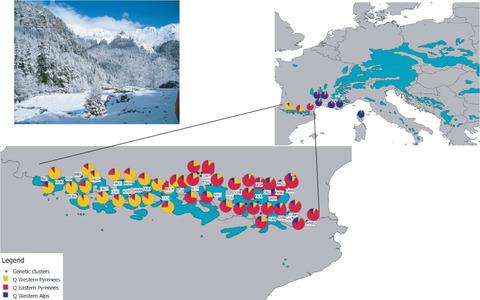当前位置:
X-MOL 学术
›
Ecol. Evol.
›
论文详情
Our official English website, www.x-mol.net, welcomes your
feedback! (Note: you will need to create a separate account there.)
Signature of mid-Pleistocene lineages in the European silver fir (Abies alba Mill.) at its geographic distribution margin
Ecology and Evolution ( IF 2.3 ) Pub Date : 2021-07-21 , DOI: 10.1002/ece3.7886 Caroline Scotti-Saintagne 1 , Thomas Boivin 1 , Marie Suez 1 , Brigitte Musch 2 , Ivan Scotti 1 , Bruno Fady 1
Ecology and Evolution ( IF 2.3 ) Pub Date : 2021-07-21 , DOI: 10.1002/ece3.7886 Caroline Scotti-Saintagne 1 , Thomas Boivin 1 , Marie Suez 1 , Brigitte Musch 2 , Ivan Scotti 1 , Bruno Fady 1
Affiliation

|
In a conservation and sustainable management perspective, we identify the ecological, climatic, and demographic factors responsible for the genetic diversity patterns of the European silver fir (Abies alba Mill.) at its southwestern range margin (Pyrenees Mountains, France, Europe). We sampled 45 populations throughout the French Pyrenees and eight neighboring reference populations in the Massif Central, Alps, and Corsica. We genotyped 1,620 individuals at three chloroplast and ten nuclear microsatellite loci. We analyzed within- and among-population genetic diversity using phylogeographic reconstructions, tests of isolation-by-distance, Bayesian population structure inference, modeling of demographic scenarios, and regression analyses of genetic variables with current and past environmental variables. Genetic diversity decreased from east to west suggesting isolation-by-distance from the Alps to the Pyrenees and from the Eastern to the Western Pyrenees. We identified two Pyrenean lineages that diverged from a third Alpine–Corsica–Massif Central lineage 0.8 to 1.1 M years ago and subsequently formed a secondary contact zone in the Central Pyrenees. Population sizes underwent contrasted changes, with a contraction in the west and an expansion in the east. Glacial climate affected the genetic composition of the populations, with the western genetic cluster only observed in locations corresponding to the coldest past climate and highest elevations. The eastern cluster was observed over a larger range of temperatures and elevations. All demographic events shaping the current spatial structure of genetic diversity took place during the Mid-Pleistocene Transition, long before the onset of the Holocene. The Western Pyrenees lineage may require additional conservation efforts, whereas the eastern lineage is well protected in in situ gene conservation units. Due to past climate oscillations and the likely emergence of independent refugia, east–west oriented mountain ranges may be important reservoir of genetic diversity in a context of past and ongoing climate change in Europe.
中文翻译:

欧洲银杉(Abies alba Mill.)中更新世谱系在其地理分布边缘的特征
从保护和可持续管理的角度来看,我们确定了欧洲银杉( Abies alba Mill.)西南边缘(法国比利牛斯山脉,欧洲)遗传多样性模式的生态、气候和人口因素。我们对法国比利牛斯山脉的 45 个种群以及中央高原、阿尔卑斯山和科西嘉岛的 8 个邻近参考种群进行了采样。我们对 1,620 个个体的三个叶绿体和十个核微卫星位点进行了基因分型。我们使用系统发育地理学重建、距离隔离测试、贝叶斯种群结构推断、人口情景建模以及遗传变量与当前和过去环境变量的回归分析来分析种群内和种群间的遗传多样性。遗传多样性从东到西减少,表明从阿尔卑斯山到比利牛斯山脉以及从东比利牛斯山脉到西比利牛斯山脉存在距离隔离。我们发现了两个比利牛斯山谱系,它们在 0.8 至 110 万年前与第三个阿尔卑斯山-科西嘉-中央高原谱系分叉,随后在比利牛斯山脉中部形成了次要接触带。人口规模发生了西部地区收缩、东部地区扩张的对比变化。冰川气候影响了种群的遗传组成,西部遗传簇仅在与过去最冷的气候和最高海拔相对应的位置观察到。东部星团是在较大范围的温度和海拔范围内观察到的。所有塑造当前遗传多样性空间结构的人口事件都发生在中更新世过渡期间,早在全新世开始之前。 西比利牛斯山脉谱系可能需要额外的保护工作,而东部谱系在原位基因保护单元中得到很好的保护。由于过去的气候波动和独立保护区的可能出现,在欧洲过去和当前气候变化的背景下,东西向的山脉可能是遗传多样性的重要库。
更新日期:2021-08-16
中文翻译:

欧洲银杉(Abies alba Mill.)中更新世谱系在其地理分布边缘的特征
从保护和可持续管理的角度来看,我们确定了欧洲银杉( Abies alba Mill.)西南边缘(法国比利牛斯山脉,欧洲)遗传多样性模式的生态、气候和人口因素。我们对法国比利牛斯山脉的 45 个种群以及中央高原、阿尔卑斯山和科西嘉岛的 8 个邻近参考种群进行了采样。我们对 1,620 个个体的三个叶绿体和十个核微卫星位点进行了基因分型。我们使用系统发育地理学重建、距离隔离测试、贝叶斯种群结构推断、人口情景建模以及遗传变量与当前和过去环境变量的回归分析来分析种群内和种群间的遗传多样性。遗传多样性从东到西减少,表明从阿尔卑斯山到比利牛斯山脉以及从东比利牛斯山脉到西比利牛斯山脉存在距离隔离。我们发现了两个比利牛斯山谱系,它们在 0.8 至 110 万年前与第三个阿尔卑斯山-科西嘉-中央高原谱系分叉,随后在比利牛斯山脉中部形成了次要接触带。人口规模发生了西部地区收缩、东部地区扩张的对比变化。冰川气候影响了种群的遗传组成,西部遗传簇仅在与过去最冷的气候和最高海拔相对应的位置观察到。东部星团是在较大范围的温度和海拔范围内观察到的。所有塑造当前遗传多样性空间结构的人口事件都发生在中更新世过渡期间,早在全新世开始之前。 西比利牛斯山脉谱系可能需要额外的保护工作,而东部谱系在原位基因保护单元中得到很好的保护。由于过去的气候波动和独立保护区的可能出现,在欧洲过去和当前气候变化的背景下,东西向的山脉可能是遗传多样性的重要库。











































 京公网安备 11010802027423号
京公网安备 11010802027423号